This blog exists to inspire change--to become more in harmony with nature, to appreciate our beautiful planet, and to help preserve it for future generations.
Tuesday, December 18, 2007
What Happens after Bali?
"If we place a price on carbon, that will spur development of technologies and dissemination of technologies by which we might be able to save different parts of the world from some of the more serious effects of climate change that otherwise we would encounter."
May Jeong, Canadian Youth Delegation member to Bali and co-author of Option 13, believes it's now or never."I am 20 years old and would like to come back to Bali with my children someday and not find it underneath a rising sea. The time to act is long overdue. Use this plan, or come up with something better, and do it fast."
To download the full report: http://www.option13.org/Option13.pdf
For further information: In Bali: Toby Heaps, 62 859 3532 5134 May Jeong, 62 819 360 85562 Toronto Headquarters: (416) 203-4674, toby@corporateknights.ca www.corporateknights.ca
Thursday, December 13, 2007
Consumerism explained
Check out an interesting 20 minute video here:
http://www.storyofstuff.com/
Wednesday, December 12, 2007
Quote from Thomas Edison...
Thomas Edison, 1847 - 1931
Bali: Canada voted worst in world!?
http://www.avaaz.org/en/another_canadian_climate_crime/98.php?CLICK_TF_TRACK
Prime Minister Harper's short-sighted, big oil-driven policy on climate change is damaging the world and destroying our image as a good country. We're supposed to be the nice guys, who try to do the right thing in the world. The vast majority of Canadians are hopping mad on this issue -- we can win this. We just need to show Harper how serious we are that he change course. Sign up now and forward this email to everyone you know - we've got just 3 days to hit 25,000 signatures!
Here are links to some more info on this:
David Suzuki (the Nature of Things) calls the government's spin on climate change "humiliating" and "ludicrous" http://www.thestar.com/News/article/283829
The former editor-in-chief of CBC news discusses the damage done by Canada's climate policy to our international reputation: http://www.cbc.ca/news/viewpoint/vp_burman/2007/12/canada_flounders_on_issue_of_c.html
Thursday, December 6, 2007
Congestion Pricing Deal Struck in NYC
 For immediate release: Thursday July 19, 2007
For immediate release: Thursday July 19, 2007Wednesday, December 5, 2007
New Mobility Model
What is striking about this is that the main driver for this new mobility model lies not in fears of environmental catastrophe or oil shut-down, and not even in our collective good sense or ethics --but rather in the fact that enough successful new practices and models are starting to show results that we now, finally, start to have real choices. The climate issues give us a global frame and strong sense of urgency; the New Mobility Agenda tell us how to get the job done.
[Reinventing Transport in Cities]
Old Mobility model in Los Angeles:
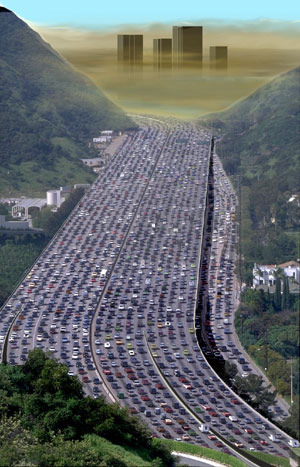
Metrolinx (formerly GTTA) releases Discussion paper #1

Tuesday, December 4, 2007
Main streets
"Single-use zoning, low-density development, and space-hogging automobile infrastructure make life without driving seem a fanciful notion."
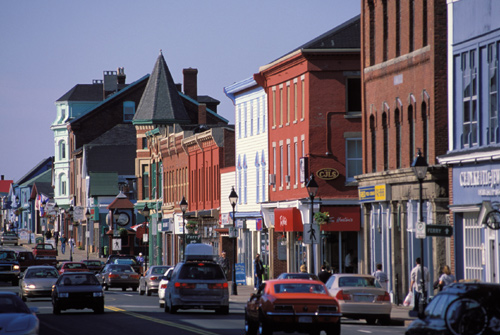
Monday, December 3, 2007
Cliclovia - Car Free Sundays
http://www.streetfilms.org/?cat=19
Ciclovia – Car Free Sundays
NEW Video. Clarence Eckerson, November 30, 2007
Do you want to get hundreds of thousands physically active, walking and bicycling? Using the infrastructure that you already have? No need of capital investment, just operational budget, political will (guts), and community engagement is needed. It works just as well in a city of 50,000 people than in one of 10 million, anywhere in the world. It is CAR FREE SUNDAYS. It's a weekly event in which over 70 miles of city streets are closed to traffic where residents come out to walk, bike, run, skate, recreate, picnic, and talk with family, neighbors & strangers.
Friday, November 30, 2007
Subsidizing Auto Dependency
The Sierra Club's John Holtzclaw, one of the foremost transportation analysts in the environmental community, compiled five major efforts to calculate the total subsidies that support automobile usage. Auto subsidies in the U.S. are almost certainly greater than the entire defense budget; the five estimates ranged from $378 billion to $730 billion per year. The average subsidy ranged from $1,040 to $4,630 per vehicle beyond charges paid by drivers, amounting to $2.20 to $10.70 per gallon of gas consumed. (From Moving Lightly, Living Lightly, December 1993; newsletter of the Sierra Club Urban Environment Committee and Transportation Subcommittee, 730 Polk Street, San Francisco, CA 94109, 415-776-2211. Note: This issue is a great resource with a compendium of book reviews and a list of over 100 grassroots Sierra Club activists from 34 states and the issues they work on.)
The costs of suburban sprawl constitute a subsidy borne by the public that encourages developers to buy cheap land on the fringes of town. The Urban Land Institute estimates that it costs $48,000 per housing unit to provide roads, water, utilities, sewer, and schools to sprawling subdivisions 10 miles from town, twice as much as more compact neighborhoods adjacent to town. (The Costs of Alternative Development Patterns. James E. Frank, The Urban Land Institute, 1989.)
The more you look, the more auto subsidies you find. While citizens cannot deduct legal costs when accused of misdeeds, corporations can, even when they admit they are guilty. For example, after Exxon agreed to pay $1 billion in compensation for the Valdez oil spill, they saved half that much on their taxes. Dawn Erlandson, green tax reform specialist at Friends of the Earth, reports that, "under the current tax code, civil damages, clean-up costs, legal fees, and even the value of the (spilled) oil that devastated Prince Williams Sound are tax-deductible."
http://www.selfpropelledcity.com/read.php?spcart=4&spcindex=400&spcfetch=10
Monday, November 26, 2007
Wednesday, November 21, 2007
Development in Vaughan

In 1993, housing development began in the area of what was Maple Airport and to the northwest. In 1995, it expanded to the western part of Maple. Between 1997 and 1999, urban developments reached the northwestern part of Maple and Melville and the Don to the train tracks. Developments also reached the northeastern part and the southeastern part. Megalot houses began developing northeast of Maple near Dufferin in the late-1990s. The housing developments began up to the Highway 400 in the northwest. Housing developments have begun near Vellore.
As of 2001, developments reached the northwestern part as far as Highway 400, Teston Road, the CN line and the southwest. Most of the housing developments in the early-2000s reached Pine Valley Drive in the southwest in Vellore Village and Vellore Woods. The housing and urban developments is currently in the west between Highway 400 and Weston and Major Mackenzie and will reach to Teston.
Most recently there is a new subdivision being developed in the eastern part of Maple between bounded by Dufferin, Major Mackenzie and Rutherford Road. The name of the area is Thornberry Woods/Eagle Hills/Mackenzie Chase. Some of the builders include Greenpark Homes, Treasure Hill Homes, Tiffany Park Homes, Royal Pine Homes, Century Grove Homes, Primont Homes, Edenbrook Homes and Fernbrook Homes and Remington Homes (Thornhill Valley). Some of the street names like "Peter Rupert Avenue" reflect the history of Maple. This new area is directly south of Eagle's Nest Golf Course. This area known as Block 18 has just started development. Its proximity to Richmond Hill, Thornhill (also part of Vaughan) and the Golf Course are making the area very high demand and it is showing in the prices. "Upper Thornhill" (a misnomer name, given to the area by developers for marketing purposes) bounded by Dufferin to the west, Bathurst to the east, Major Mac to the south and Teston to the north is popularly considered a part of Maple.
The Vaughan planning area that includes Block 18 (East Maple), Block 11 (Thornhill/Maple), Block 12 (Upper Thornhill/Maple) and Block 10 (Thornhill Woods) is expected to grow substantially over the next few years. This area is known as the "Carville District"
New areas at the Maple/Thornhill Carville urban village include Thornhill Woods, Coronation, Roxborough, Upper Thornhill Estates, Thornberry Woods, Eagle Hills, Mackenzie Chase, Laureate Walk.
Valleys of Thornhill, also popularly considered part of Maple is also in the early stages of it's development with homes ranging from $400k - $1.2 million
Maple's proximity to Toronto and its major transportation corridors, and Vaughan's own political support for development, have led to the heavy development and heavy population growth. This development brings a great deal of money to the City of Vaughan, as well as the local economy, but at the same time Vaughan is frequently accused of allowing uncontrolled sprawl; Maple is arguably the most prominent example of this. In particular, those that travel up the 400 infrequently notice how much further north the development has moved even in short timeframes. Visitors to Canada's wonderland often remember that ten years ago the amusement park was surrounded by fields; and particularly in the early-mid 2000s has become surrounded by thousands of new houses. Critics suggest that denser, more central development would conserve land and allow the provision of more efficient urban services such as public transit, services traditionally thwarted by the spread-out subdivisions and lack of a dense and central downtown typical of most cities of Maple's size.
[Source: Wikipedia]
Tuesday, November 20, 2007
Tragedy of the Commons
Tragedy of the commons originated from a parable published in 1833 by William Forster Lloyd. The theory itself, however, dates back to Aristotle who said:
“That which is common to the greatest number has the least care bestowed upon it.”
One example of this tragedy of the commons is driving. More people driving more to satisfy their individual needs is actually a tragedy in two ways. Firstly, road capacity gets used up causing traffic congestion for everyone. But more importantly, and tragic, is the global warming, environmental degradation, and the destruction of cities caused by cars, and yet, people drive on.
-S
Monday, November 19, 2007
Mobility Justice
Sunday, November 11, 2007
A Call For Better Transportation in Vaughan
Vaughan is an unfriendly place for those who manoeuvre its streets with a bike or two feet. When cycling in downtown Maple, one has to either risk their life on Major MacKenzie Drive or break the law by riding on the sidewalk. Canadian motorists make an average of 2,000 trips each year that are less than three kilometres, trips that can easily be made by bike. York Region Cycling and Pedestrian Master Plan proposes only 1.5 km of additional bike lanes in Vaughan in the next five years. When priorities are right, a street can be transformed into a vibrant place for people. It's obvious that priorities are elsewhere.
At Vaughan Corporate Centre (Hwy 400 & Hwy 7), the big box stores with their massive free parking lots make walking from one store to another very challenging. Moreover, all this pavement is where nature was before. Where do the birds go? What effect does this have on our watercourses and the air we breathe?
The GO Train takes only 35 minutes from Maple to Union Station. Fantastic! But with only four trains in the morning and evening, Monday to Friday, there is standing-room only. What about those who work in North Toronto, or to the East or West? There are few alternatives to driving, except spending a very long time travelling by bus. In Vaughan, the majority who take transit do so because they don't have an available vehicle, not because it's easier or more convenient. Far from it.
Imagine our City with dedicated lanes for buses and light rail that come every five minutes, so people would choose not to drive. Imagine a network of bikeways throughout the City that would take you anywhere you want to go, with vibrant public spaces to walk and socialize in the absence of noisy traffic. What a wonderful place it would be. We need decision-makers to champion a better transportation system. A happier, healthier, and more sustainable future depends on it!
-S
6 lanes of traffic lanes, but no bike lanes
Check out the state of this sidewalk at Keele and Steeles, as you enter Vaughan!
Buses inch along in rush hour traffic
Cars are the priority here... no sidewalk.
Wednesday, November 7, 2007
MOTOR VEHICLE FUEL CONSUMPTION STANDARDS ACT PROCLAIMED
 OTTAWA — The Honourable Lawrence Cannon, Minister of Transport, Infrastructure and Communities, and the Honourable Gary Lunn, Minister of Natural Resources Canada welcomed the proclamation into law of the Motor Vehicle Fuel Consumption Standards Act (MVFCSA).
OTTAWA — The Honourable Lawrence Cannon, Minister of Transport, Infrastructure and Communities, and the Honourable Gary Lunn, Minister of Natural Resources Canada welcomed the proclamation into law of the Motor Vehicle Fuel Consumption Standards Act (MVFCSA)."Regulating the fuel efficiency of new motor vehicles is an important element of the Government's legal framework for reducing greenhouse gas emissions. Proclaiming the Act is an important step towards achieving one mandatory national standard," said Minister Cannon.
"The proclamation of this act is good news for Canada," said Minister Lunn. "Setting mandatory fuel consumption standards will lead to sustained improvements in fuel efficiency and help to reduce greenhouse gas emissions from vehicles purchased in Canada."
In 2005, the Government of Canada and the Canadian automotive industry signed a Memorandum of Understanding (MOU) stipulating that the Canadian automotive industry would take actions to voluntarily reduce greenhouse gas (GHG) emissions of new vehicles in Canada. The agreement called on the automobile industry to cut GHG emissions from light-duty vehicles (cars, minivans, sport utility vehicles and pickup trucks) so that by 2010, annual emissions reductions will reach 5.3 megatonnes (Mt).
Under the MVFCSA, fuel consumption standards will be established for light-duty road motor vehicles. These standards will come into force following the expiration of the MOU between the auto industry and the Government of Canada in 2010 and will be implemented for model year 2011.
MVFCSA standards will be developed with input from stakeholders. They will be designed for Canada to maximize our environmental and economic benefits, will be achievable within the integrated North American market and will be benchmarked against a stringent, dominant North American standard. The new standards will be published by the end of 2008.
For more information on the Government of Canada's ecoTRANSPORT initiatives, please visit http://www.ecoaction.gc.ca/
Tuesday, November 6, 2007
Stop the Alberta Tar Sands!
 The tar sands are one of the most dangerous and dirty sources of energy on the planet. The destructive impact of extracting oil from the tar sands is being felt across the province. The people of Alberta are already suffering from environmental and social problems caused by the tar sands. Old growth forests are ripped from the ground and discarded to make way for giant earthmovers to dig up the landscape, an important habitat to wildlife. If all of the proposed leases for tar sands development are granted, the tar sands will encompass an area the size of Florida.
The tar sands are one of the most dangerous and dirty sources of energy on the planet. The destructive impact of extracting oil from the tar sands is being felt across the province. The people of Alberta are already suffering from environmental and social problems caused by the tar sands. Old growth forests are ripped from the ground and discarded to make way for giant earthmovers to dig up the landscape, an important habitat to wildlife. If all of the proposed leases for tar sands development are granted, the tar sands will encompass an area the size of Florida.It is totally irresponsible for the Alberta government to push for more development in the face of the dire consequences of global warming. If politicians were really concerned about the health of their constituents and the environment, they would be weaning the province off oil and developing clean, renewable energy such as solar, geothermal, and wind power. The solutions exist; what is lacking is the political will.

Stop the Tar Sands, Mr. Stelmach!
If you live in other parts of Canada, write to Prime Minister Harper demanding that he end all access to the accelerated capital cost allowance tax break to any tar sands projects immediately, and ensure that hard emissions reductions targets are enforced in the industry:
Stop the Tar Sands Mr. Harper!
Find out more at www.greenpeace.ca/tarsands
Monday, November 5, 2007
Jim Bradley, Ontario's new Minister of Transportation
 Toronto Star
Toronto StarMonday, November 5, 2007
Environmentalists bet on Bradley
New transportation minister expected to exert influence well beyond his portfolio
Peter Gorrie - Environment Reporter
A surprise name comes up when environmentalists assess Ontario's new cabinet. They tout Jim Bradley as the minister, among the half-dozen with a direct impact on green issues, who offers the most hope for progress.
Yes, that Jim Bradley – the gregarious 30-year Legislature veteran from St. Catharines who's been nearly invisible during the past four years in stints as the minister for seniors and tourism, and government house leader.
His new job, minister of transportation, isn't much more of a political powerhouse than those others.
But green observers say transportation policies will be crucial in deciding southern Ontario's environmental fate. They also expect Bradley to wield strong influence beyond the borders of his ministry.
They are pleased by the choices for all six ministries, announced last Tuesday, which include John Gerretsen in Environment, Gerry Phillips at Energy, Donna Cansfield in natural resources, Jim Watson in Municipal Affairs and David Caplan, returning as minister of public infrastructure renewal.
"None of the six is a lead weight; none are anchors," says Chris Winter, executive director of the Conservation Council of Ontario. "They all have the potential to move their agenda forward. We're miles ahead of where we were 20 years ago."
Advocates are also pleased by the government's apparent recognition that environment issues aren't separate from others – as, for example, with the recent report that linked the spread of diabetes to the sedentary lifestyle encouraged by car-dependent suburbs.
"You can see how these things fit together," says Julia Langer, of World Wildlife Fund Canada. Agriculture ministry support for local food buttresses the climate-change plan. Several ministries must mesh to ensure new housing is never more than an easy walk from a transit stop. "The cabinet has to have more than one environment minister."
But Bradley occupies a special place, partly because of his record as environment minister under then-premier David Peterson from 1985 to '90, but also because he's reputed to have been a quiet force since the Liberals regained power in 2003.
"Bradley is considered to be the father of the modern environmental government," says David Donnelly, a lawyer who works on issues such as urban sprawl, building standards and protection of Lake Simcoe.
Among other things, Bradley stared down nickel-smelting giants Inco. Ltd. and Falconbridge Ltd. and other industries that caused acid rain, and, over strong business objections, pushed through regulations that reduced toxic pollution from sewer pipes.
Now, he's in charge of a ministry that's fixated on more and bigger highways and bridges, and that critics argue must shift to support public transit, cycling and walking.
"He does a wonderful `aw shucks' routine," Donnelly says. But "very few people are shrewder.
"He holds a great deal of sway with the cabinet....I expect him to fight and, based on his past history, I expect him to win."
Winter adds: "He had a lot of spine back then (as environment minister) and I don't think he's lost it."
In their most optimistic moments, environmentalists picture Bradley killing plans for new expressways through the Greenbelt – the extension of Highways 404 and 407 and a new route along the Niagara Peninsula and across York Region's mid-section.
More realistically, they say he might reduce the scale of those massive road plans, which seem to fly in the face of the government's claim to want more compact, transit- and pedestrian-friendly communities.
A cautious Bradley, still busy moving to his new office, says he hasn't yet "turned my attention" to that issue. He is certain, though, that much of his effort will focus on how to spend the $17.5 billion Premier Dalton McGuinty has pledged for transit projects.
The other five ministers have reasonable green credentials but those with track records get mixed reviews.
Gerretsen, former mayor of Kingston, earns high marks for creating the Greenbelt over strong objections from developers and landowners. He's downgraded, though, for approving energy-efficiency standards for new houses that Donnelly calls "disappointing."
Caplan, with part of the responsibility for containing sprawl, is praised for general direction but considered weak on putting it into practice. Phillips strongly backed the creation of the Rouge Valley park on Toronto's eastern border.
Friday, November 2, 2007
$17B for transit; that's good, right?
$17B for transit; that's good, right?
Toronto Star, P. A06, October 17, 2007
You can call it the quietest $17 billion gift ever promised the Toronto region in our lifetime - such has been the low-key, almost "I don't believe it" reaction to the province's stupendous funding announcement for public transit. Aired in June, the plan purports to fund just about every wish-list project in Toronto, 905 and Hamilton - busways and LRTs and subway and GO rail extensions. You'd think they'd be screaming in orgasmic delight from the clamshell at Toronto City Hall to the far-flung bedroom communities whose workers must traverse the GTA each day. You'd think there would have been a huge news conference, replete with town crier and horns and ribbons and pronouncements that the holy grail has finally been seized and the Toronto region had finally reached transit nirvana.
______________________________________
Get "GO-ing" on commuter rail
Metroland - Brampton Division, P. 1, October 17, 2007
Town officials are pressuring the province's new transportation authority to put the pedal to the metal to address gridlock on local roads. Council passed a motion last Tuesday calling on the Greater Toronto Transportation Authority (GTTA) to expedite the 'planning and environmental assessment process, including negotiations with Canadian Pacific Rail, for a new GO rail line between Bolton and Union Station.' "Not only will this help with gridlock on (Highway) 427, it will also help with gridlock on Highway 50 south of Mayfield Road," said Bolton Regional Councillor Annette Groves, of providing GO train service to her community. The motion also calls on the GTTA to create commuter carpool lots with connecting GO bus services in Caledon to encourage commuters to 'park and ride'.
With Jim Bradley as the new Minister of Transport, it appears that GO Transit has a good chance of expanding service to places like Niagara Region. -S
Sunday, October 28, 2007
The American way of life is a blessed one?

Monday, October 22, 2007
Air pollution decreases on Yom Kippur in Israel

Daddy! Mommy!" The traffic lights are madly blinking stop! Go! Stop! Go! And of course, no one is taking any notice. The birds are calling to each other above the roof tops. Caw caw!! Chirp chirp!! Wooooo wooooooo goes the dry north wind. You can even hear crickets by the usually bustling beachfront promenade. it is all quite delightful.
By Zafrir Rinat, Haaretz Correspondent
Air pollution in Jerusalem and the Dan region was 100 times less on Yom Kippur than on ordinary days, when cars are on the roads, air pollution monitors from the Environmental Protection Ministry found.
Thursday, October 18, 2007
Street car was desired in York Region of old
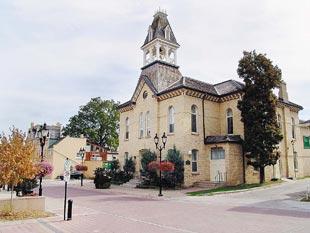
Newmarket street car service? It's been done before
Tuesday, October 16, 2007
Green Party's Vision for transportation

The Green Party's full vision can be found here
http://www.greenparty.ca/en/policy/visiongreen?origin=redirect
Railroads – re-establishing the national dream
Canada’s national rail systems are in decline. We are the only country in the Organization of Economic Cooperation and Development (OECD) with no national transportation strategy. While Europeans have highly efficient inter-modal connectivity, with high speed rail linking downtown cores to airports, with bicycle lanes allowing people to move around cities safely, efficiently and pollution-free, with streetcars in the downtowns and even rural areas serviced by bus and rail, Canadian communities are increasingly stranded. Nothing links our downtowns to airports other than a stretch of gridlocked traffic. Even along the Windsor-Quebec corridor, passenger rail is increasingly infrequent and outmoded. In much of Canada, rail routes that once moved thousands of people are abandoned. Edmonton to Calgary, Saskatoon to Regina, Halifax to Sydney have all been axed, despite their profitability.
Vision
Sir John A. Macdonald understood that to be a nation, to have a sense of shared identity and common purpose, Canada needs effective east-west links in communications, in energy delivery and in transportation.
To renew this “national dream” today requires a complete overhaul of our rail system for both passenger and freight. It will mean shifting cargo containers off highways and onto freight trains, driving the development of freight distribution nodes (off-loading containers onto local trucks) along new “green corridors”.
The rail system changes will include a separate line for passenger trains. At the moment, freight owns the tracks and controls the traffic signals. Passengers are at the mercy of freight. New high-speed commuter trains will almost halve the travel time between Toronto and Ottawa and Toronto and Montreal to about two and a half hours. With downtown-to-downtown service, the train will be faster than the plane, especially when security and other airport delays are factored in. Reducing air travel will reduce greenhouse gases and remove the need to expand airports or build new ones, including the Pickering airport near Toronto. Better rail service will take cars off the roads between major cities, reducing air pollution, congestion and loss of life in traffic accidents. An improved rail system will make Canada more economically competitive and provide thousands of new jobs.
Green Solutions
Green Party MP’s will re-establish Canada’s National Dream and:
- Re-invest in our national rail systems, building more train cars in Canada, and create green transportation and energy infrastructure corridors in key regions.
- Improve rail infrastructure and intermodal connections, increasing joint federal-municipal light rail investments, as well as improving VIA rail service nationwide.
- Work with railway companies to improve rail infrastructure and to restore VIA rail service to all major regional cities.
- Create a national clean freight initiative, using both regulation and financial incentives to improve fleet efficiency and safety.
- Support the trucking industry, reducing pollution through add-on generators to avoid the need to idle to maintain air conditioning and refrigeration, while ensuring the right fit of trucking in a more efficient, rail-based intermodal system.
Urban sprawl means commuters crawl. More roads don’t solve the problem, they make it worse, quickly filling up with more cars. Gridlock means more air pollution and greenhouse gas emissions. We have to break this vicious cycle.
Vision
We must build our way out of the problem of clogged roads and smog-choked cities, not by building more roads and bridges and more distant suburbs, but with “smart growth” infrastructure. Excellent public transit and efficient housing in high-density nodes along existing transit corridors will make cities livable and people friendly. The federal government must take the lead in funding the “greening” of Canada’s cities. (For more details also see the section on government: Federal-Municipal Relations.)
Green Solutions
Green Party MPs will:
- Increase federal funding for pedestrian, cycle and car-sharing infrastructure in towns and cities.
- Double existing funding to stimulate a massive re-investment in public transportation infrastructure in all Canadian towns and cities to make it convenient, safe, comfortable and affordable.
- Make transit passes tax-deductible to encourage workers and businesses to use public transport and provide financial support to provinces that provide free public transit passes to people living below the poverty line.
- Cancel all funding for specific highways and bridge expansions (like the Gateway Program in Greater Vancouver) that encourage urban sprawl, increase private vehicle use, truck transport of goods and consequently increases greenhouse gas emissions.
- Ensure federal infrastructure funding does not go to expanding highways and roads.
Monday, October 15, 2007
Saturday, October 13, 2007
Friday, October 12, 2007
New roads make it easy to ignore public transit
October 9, 2007
MCNAUGHTON ROAD EAST
“The completion of the McNaughton Road extension will have a positive effect on our community as it will allow the City to provide the appropriate infrastructure to relieve gridlock through Maple on Major Mackenzie and help attract and retain businesses,” said Mayor Linda Jackson. “The extension is especially important to the redevelopment and intensification of the existing Civic Centre site.”
York Major Holdings constructed the capital work on the City’s behalf in order to accelerate the development of their nearby lands. City Council authorized completion of the extension in April 2003.
“The extension and the development of York Major Holdings’ land is an important part of the City’s strategy with respect to the closure of the Keele Valley Landfill,” said Ward 1 Councillor Peter Meffe. “It will also encourage redevelopment of the secondary buffer zone of the landfill.”
The new four-lane road runs east 1.6 kilometres and connects to the existing
The extension is adjacent to the former Keele Valley Landfill Site. These lands, with an area of approximately 245 hectares, are being rehabilitated under the Maple Valley Plan that includes new parkland and natural open spaces, and some commercial development.
The Record
Thu
New roads make it easy to ignore public transit
Byline: Shelley Maw
As long as we continue to build more roads in
Human beings do not change their ways of doing things until their current method becomes unbearable, and when there is an alternative that is reasonably convenient and affordable.
If we keep making driving easier and more convenient, we might as well save our breath (and our money) trying to sell the idea of leaving our cars at home and taking public transit.
Why do people in this region take public transit? By far the majority of those who do, do so because they don't have an available vehicle. Why do those of us who drive not take public transit? Because it is neither easier nor more convenient. Far from it. Why do many of us take public transit to or in
Forget a new Highway 7 and the proposed 424 bypass, and give us a public transit alternative that is reasonably simple and convenient.
Eventually the traffic nightmares will push us to use it. If you solve the traffic congestion problem, we won't change our car habit.
Thursday, October 11, 2007
Has Toyota No Shame?
Toyota has sold more than one million Prius hybrids to environmentally conscious consumers who want to do the right thing for our planet.
But, incredibly, the company is now forsaking us by opposing the first improvement in U.S. fuel economy standards in nearly 20 years!
Please tell Toyota to get back in gear by supporting a measure that guarantees a fuel economy standard of 35 miles per gallon by 2020 for cars and light trucks.
Congress is negotiating an energy bill right now that could do just that -- and save America 1.2 million barrels of oil each day by 2020, more than we import from Saudi Arabia.
But the Alliance of Automobile Manufacturers -- the powerful lobbying group that includes Toyota -- is claiming that a 35 m.p.g. average for cars and trucks is "unattainable."
Go tell the maker of the 50-m.p.g. Prius to get out of reverse!
Thank you for taking action to reduce America’s dangerous dependence on oil.
Wednesday, October 10, 2007
Tuesday, October 9, 2007
Bells on Bloor 2007
dubbed TaketheTooker.
Viva ! La Velorution !
..~......__o..__o
.~.. _.-\.<,.-\.<,_
~...(_)./.---./....(_)
Monday, October 8, 2007
Some modest proposals to liberate city streets
A conference here this week aimed to turn around a half-century of car-driven urban planning, Oct 06, 2007 04:30 AM
The sidewalks are wide. They're lined with flowers and trees. There's a bus stop, a bench, maybe even a small park. There's room for bikes and cars, but children and seniors don't have to worry about being run over.
That's the street everybody wants to live on, shop on, work on and walk on.
The planners and engineers know how to build it.
So, why are so many of us trapped in labyrinthine suburbs where, even if we want to walk, we imperil our lives doing so on the gravel shoulders of arterial roads?
There are significant challenges to altering more than half a century of automobile-centred urban design, not the least of which is political inertia, according to the experts at an international walking conference here this week.
But there's also a growing movement of pedestrians and cyclists ready to turn the transportation hierarchy on its head – to put people ahead of cars.
New developments can be made walkable, according to Dutch traffic engineer Hans Monderman, considered a maverick for his designs that rely more on human behaviour and less on road signs – eliminating elements like traffic lights, stop signs and lane markers altogether – to encourage civil traffic patterns.
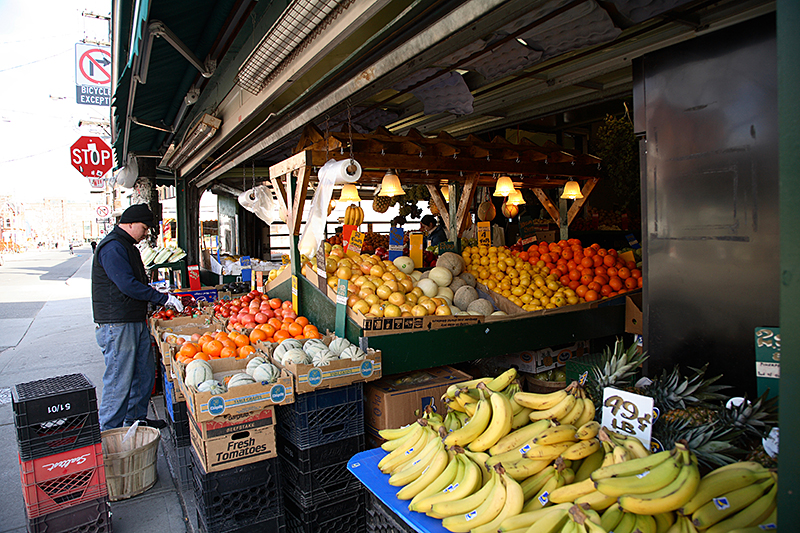 "If you want people to behave like they're in a village, you have to build a village," he said.
"If you want people to behave like they're in a village, you have to build a village," he said.
Put car windows at a level closer to curb height so motorists see pedestrians differently. Vary paving materials and landscaping according to space use. People will instinctively know what to do, says Monderman.
The British conference chair of Walk21, Jim Walker, says he's seen "lots of disgusting places, but they can be sorted."
Other cities that have hosted the event wanted to show off their pedestrian-friendly strides.
Toronto was different, Walker said, because it chose the conference as the launch date for its new pedestrian strategy, part of a sustainable transportation plan to reduce reliance on the car.
The revolution is already under way in places like Kensington Market, now closed to cars on Sunday. St. George St. south of Bloor St. is another example.
"Ten years ago, (St. George) was a four-lane road with very narrow sidewalks and no landscaping and the very simple act of brilliance was to get rid of two traffic lanes, widen the sidewalks and landscaping. (Now) the sidewalks are full all the time and you have a beautiful street with trees that will eventually arch and meet in the middle," says Toronto's former planning chief, Paul Bedford, now a teacher and consultant.
Bedford can't resist adding that a hefty private donation helped embarrass the city and the University of Toronto into tackling the project.
But it doesn't work everywhere. In 1971, Yonge St. between and King and Gerrard Sts. was turned into a pedestrian mall.
"It was great for a (while), but even though there was no traffic, people migrated naturally to the sidewalks because they didn't feel like they should walk in the middle of the road," said Bedford.
Experts admit it's tougher to retrofit the worst of 1960s- and 1970s-style planning in the old suburbs of Toronto or places like Oakville and Pickering.
Perhaps we don't view walking as an integral part of our lives like Europeans, suggests Walk21's Daniel Egan, Toronto's manager of cycling and pedestrian infrastructure.
North Americans "spend thousands of dollars to go to those places (like Europe) and walk around and then you come back to your suburban bungalow and drive everywhere.
"I don't think it's necessarily political, I think it's part of the culture where that's something you go and enjoy but you don't actually live in it," he said.
"I don't know how you turn back the clock. All these places that are great are old. They were built at a time when walking was the way you got around."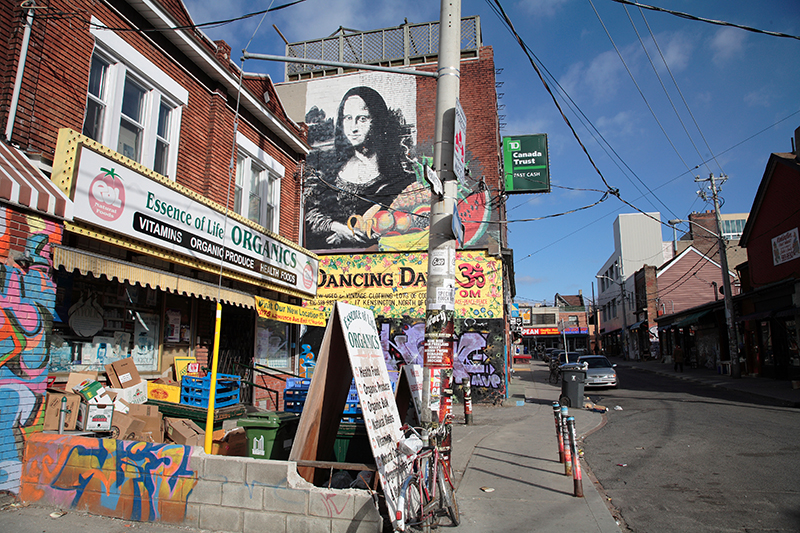 Kensington Market in Toronto has pedestrian Sundays. One doesn't fully appreciate the joy of being in a carfree zone until experiencing it firsthand. "The streets echo to human sounds: footsteps, voices, whistling porters, street musicians. People dawdle without worrying about onrushing traffic. " Carfree Cities, J.H. Crawford.
Kensington Market in Toronto has pedestrian Sundays. One doesn't fully appreciate the joy of being in a carfree zone until experiencing it firsthand. "The streets echo to human sounds: footsteps, voices, whistling porters, street musicians. People dawdle without worrying about onrushing traffic. " Carfree Cities, J.H. Crawford.The stink, roar, and danger of car and truck traffic inhibit street life.
FEET FIRST
Five ways to make more walkable cities as heard at Walk21 conference:
1. Widen sidewalks to accommodate pedestrians and put curves in roads to slow traffic. Add planters as an alternative to repaving.
2. Get rid of signs that state the obvious. Street design and buildings will tell people where to go and how to behave.
3. Bring back benches, bathrooms and drinking fountains, as well as mixed-use development.
4. Safe streets are busy streets. One way to fight intimidation is to attract lots of people.
5. Subways are expensive. You could build enough bike and pedestrian infrastructure to serve the entire region for the same price as a few kilometres of subway.
Friday, October 5, 2007
Transportation key election issue in York Region
COLUMN
No one route to better commute
By: Sean Pearce
As anyone who wakes up impossibly early every weekday morning to make the trek to Toronto for work well knows, traffic congestion isn’t going away.
Far from it.
The drive home isn’t much better.
It is then safe to say, in terms of transportation issues, York Region faces a multitude of obstacles, but has a myriad of possible solutions at its disposal.
In terms of improving public transit in the region, each party presents a slightly different approach, but all agree more is needed.
Is the subway even the best possible solution for York Region in the long haul? The Progressive Conservatives don’t seem to think so. The PCs, under John Tory, have vowed to create a new funding model for Ontario, one that sees all gas tax collected going back to municipalities.
More to the point, the much touted plan for the subway, seeing as how it may take at least four to five years to get things under way, might simply be too little too late.
The time for rapid transit and action is now, Mr. Tory said.
Roads
The Liberals seem to have recognized this and have been working away building and expanding the province’s network of high occupancy vehicle lanes in the hope if people must drive, they will, at the very least, carpool.
The PCs, among them former minister of transportation Frank Klees, have come out saying York Region needs more than future subways and even enhanced transit.
The fact remains voters are looking for action on the congestion issue and it is likely whichever proposal is most sound, the real answer will likely be a multi-pronged approach. Is more and improved public transit needed? Yes, absolutely. Too many people complain schedules are inconvenient for their lives or routes don’t go where they need them to go, so, instead, they drive.
Hopefully, as the HOV network continues its expansion, more people will be encouraged to travel with others, but the fact remains many people in this region still continue their age-old love affair with the automobile.


